Cnidarian Characteristics
- Diploblastic; endoderm & ectoderm separated by mesoglea
- Radial symmetry
- Presence of cnidae/nematocysts in cnidocytes (stinging cells) (see photo at right)
- Alternation of polyploid (polyp) and medusoid generations
- Gastrovascular cavity with single mouth/anus
- Tissue grade organization
- Additional Classes not represented in lab:
- Cubozoa: box jellies and sea wasps.
- Staurozoa: stalked jellyfish.
- Myxozoa: spore-producing parasites
|
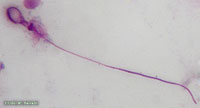
Discharged Nematocyst of Hydra sp.
|
|
|
Class Hydrozoa — Hydroids
Characteristics
- Biphasic life cycle: polypoid generation usually dominant
- Medusae usually small, transparent
- A few (fire corals) produce coral-like calcareous skeleton
- Polyps usually colonial, with interconnected coelenterons
- No cells in mesoglea
- Nematocysts only in epidermis (not gastrodermis)
- Marine and fresh waters
|
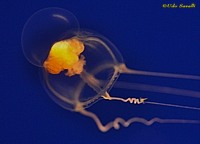
Halitholus sp. Hydromedusoid (Order Anthomedusae)
|

Bell Jelly, Polyorchis penicillatus (Order Anthomedusae)
|
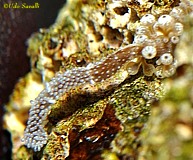
Candelabra Hydroid, Candelabrum sp. (Order Anthomedusae); note long gastrozooid covered in blunt, white tentacles and round gonozoids surrounding the base.
| |
|
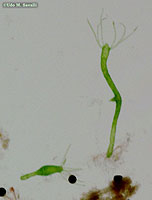
Green Hydra, Chlorohydra viridissima (Order Anthomedusae)
|
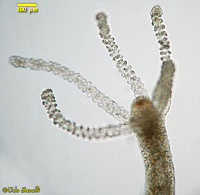
Brown Hydra, Hydra oligactis, oral end with tentacles covered in cnidocytes (Order Anthomedusae)
|

Hydra sp., stained longitudinal section, 100x (Order Anthomedusae)
See also labeled photo.
|
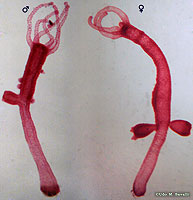
Hydra sp., stained whole mounts showing sexual and asexual reproduction, 10x
See also labeled photo.
|
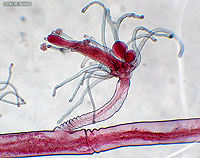
Pennaria sp. hydroid colony, stained whole mount (Order Anthomedusae)
|
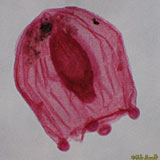
Pennaria sp. medusa, stained whole mount (Order Anthomedusae)
|
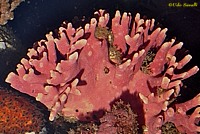
California Hydrocoral, Stylaster californica (Order Anthomedusae)
|
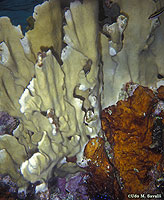
Blade Fire Coral, Millepora complanata, Belize (Order Anthomedusae)
|
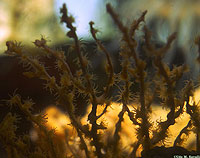
Eudendrium sp. hydroid colony (Order Anthomedusae)
|
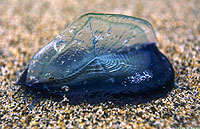
By-The-Wind-Sailor, Velella velella, beached, CA (Order Anthomedusae)
|
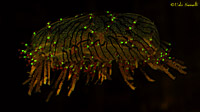
Flower Hat Jelly, Olindias formosa, with bioluminescent tentacles (Order Limnomedusae)
|
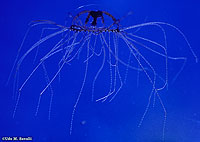
Angled Hydromedusa, Gonionemus sp. (Order Limnomedusae)
|
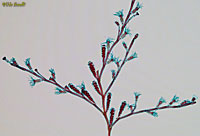
Obelia sp. colony, stained whole mount (Order Leptomedusae)
|
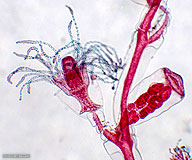
Obelia sp. polyps, stained whole mount, 40x (Order Leptomedusae)
See also labeled photo.
|
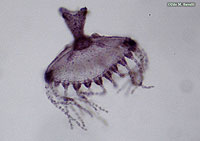
Obelia sp. medusa, stained whole mount, 100x (Order Leptomedusae)
|
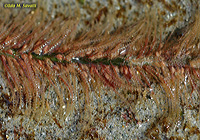
Ostrich-plume Hydroid colony, Aglaophenia sp. (Order Leptomedusae); La Jolla, CA
|
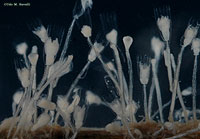
Clytia sp. hydroid colony (Order Leptomedusae); preserved specimen
|
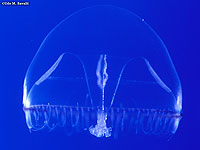
Umbrella Jellyfish, Eutonina indicans medusa (Order Leptomedusae)
|
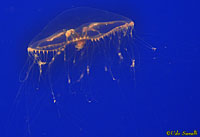
Cross Jelly, Mitrocoma cellularia medusa (Order Leptomedusae)
|
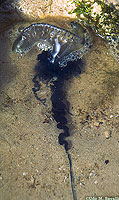
Portuguese Man-O-War, Physalia physalis, in tidepool, Kenya (Order Siphonophora)
|
|
Class Anthozoa — Anemones & Corals
Characteristics
- Lack medusoid stage
- Polyps solitary or colonial
- Coelenteron (gastrovascular cavity) subdivided by longitudinal folds of tissue
- Tentacles in multiples of 6 (Hexacorallia) or 8 (Octocorallia)
- Marine only
|
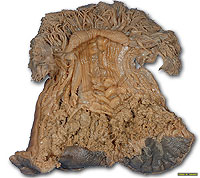
Sea anemone dissection (Metridium sp.)
Check answers on labeled photo.
|
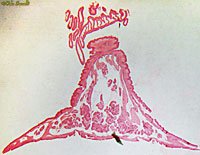
Sea anemone longitudinal section stained slide (Metridium sp.)
Check answers on labeled photo.
|
Subclass Hexacorallia (Zoantharia)
|
Order Actiniaria
- Anemones
- Polyps large, usually with distinct stalk
- Numerous tentacles
- Lack calcified skeleton
- Solitary or in aggregations but not truly colonial
|
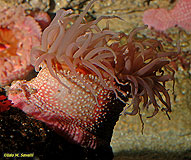
White-spotted Rose Anemone, Urticina lofotensis
|
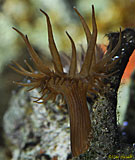
Glass Anemone, Aiptasia sp.
|
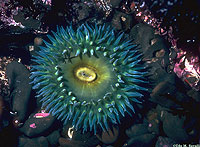
Giant Green Anemone, Anthopleura xanthogrammica, CA
|
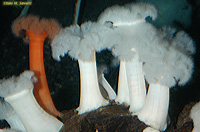
Giant Plumose Anemone, Metridium farcimen
|
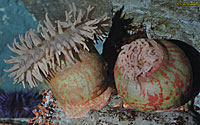
Painted Anemones, Urticina crassicornis, expanded and contracted
|

Aggregating Anemones, Anthopleura elegantissima, a clonal species
|
|
Order Scleractinia
- Stony corals
- Secrete calcareous skeleton
- Most colonial with small polyps
- But some solitary with large polyps
|
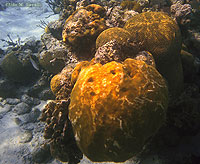
Boulder coral, Montastrea annularis (foreground) and Brain corals, Diploria sp., Belize
|
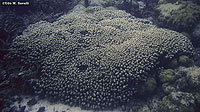
Yellow pencil coral, Madracis agaricites, Belize
|
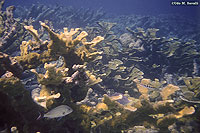
Elkhorn coral, Acropora palmata, reef, Belize
|
|
|
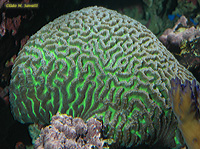
Brain Coral, Platygyra sp.
|
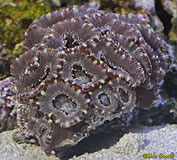
Brain Coral, Favites sp.
|
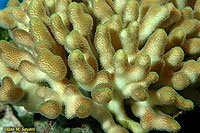
Cauliflower Coral, probably Stylophora or Pocillopora sp.
|

Flowerpot Coral, Alveopora sp.
|
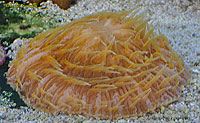
Disk Coral, Cycloseris sp., a single, large, solitary polyp
|
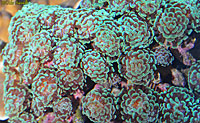
Hammer Coral, Euphyllia sp.
|
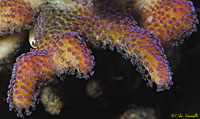
Unidentified Small-polyped Stony Coral
|

Duncan Coral, Duncanopsammia axifuga
|

Hidden Cup Coral, Phyllangia americana; a solitary polyp; its transparency allows the skeleton to be seen through the tissue; collected in FL
|

Slipper Coral, Polyphyllia sp., skeleton of a single, large, solitary polyp (similar to the disk coral, above)
|
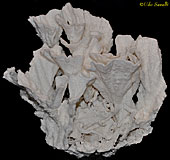
Poca Coral, Montipora sp., skeleton of a small-polyped coral
|
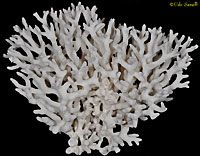
Bird's Nest Coral, Seriatopora sp., skeleton of a small-polyped coral
|
|
Other Orders
- Disk anemones, button polyps, black corals, tube anemones and others
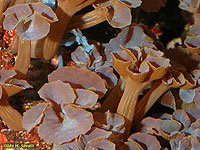
Mushroom Anemones, Discosoma sp. (Order Corallimorpharia)
|
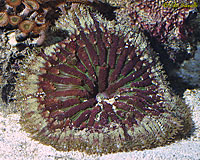
Mushroom Coral, Rhodactis sp. (Order Corallimorpharia)
|
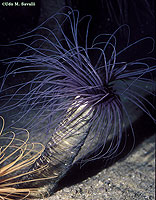
Tube Anemone, Pachycerianthis sp., (Order Ceriantharia; but often placed in its own subclass)
|
|
|
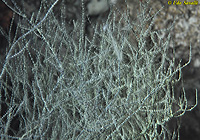
Yellow-polyp Black Coral, Antipathes galapagensis (Order Antipatharia)
|
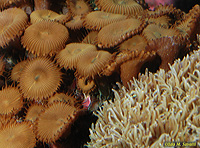
Button Polyps, Palythoa sp. (Order Zoantharia)
|
|
Extinct Fossil Corals
- Ordovician to Permian (488-251 mya)
- Rugose corals were solitary or colonial
- Tabulate corals were always colonial
|
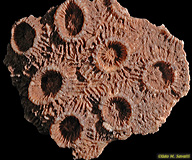
Sun Coral fossil, Pachyphyllum nevadens; Tonto N.F., AZ, Devonian Period (Order Rugosa†)
|
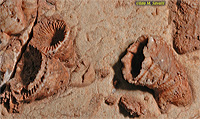
Horn Coral fossils, possibly Zaphrentis sp.; Tonto N.F., AZ, Devonian Period (Order Rugosa†)
|
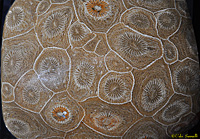
Coral fossil, Hexagonaria sp., polished; Morocco, Devonian Period (Order Rugosa†)
|
|
|
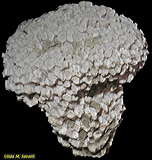
Tabulate Coral fossil; KY, Ordovician Period (Order Tabulata†)
|
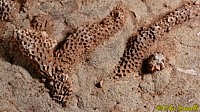
Thamnopora sp. coral branches; Tonto N.F., AZ, Devonian Period (Order Tabulata†)
|
Subclass Octocorallia (Alcyonaria)
|
Order Alcyonacea
- Soft corals, sea whips, and sea fans
- Gorgonians (sea whips and sea fans) were formerly placed in their own order, Gorgonacea
- Lack calcified exo-skeleton
- Support provided by calcareous spicules (soft corals) or proteins
- Colonies often tree-like with branching structure or may resemble anemones
|
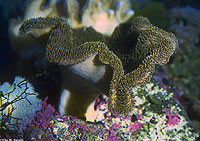
Umbrella Leather Coral, Sarcophyton trochelisphoram
|
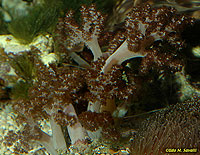
Kenya Tree Coral, Capnella imbricata
|
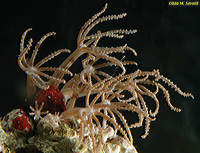
Xenia Coral, Xenia sp.
|

Blue Octocoral, Sarcothelia edmondsoni
|

Green Star Polyps, Pachyclavularia violacea
|

Toadstool Leather Coral, Sarcophyton sp.
|
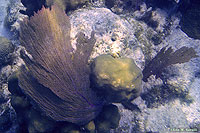
Sea Fan, Gorgonia sp., Belize
|
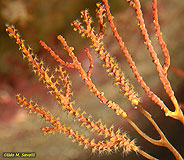
Orange Gorgonian, Adelogorgia phyllosclera?
|
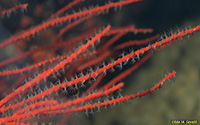
Red Gorgonian, Lophogorgia chilensis
|
|
Other Orders
- Blue corals, organ pipe corals & sea pens
|
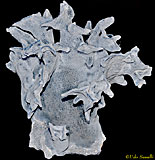
Blue Coral, Heliopora coerulea, skeleton (Order Helioporacea)
|

Organ Pipe Coral, Tubipora musica (Order Stolonifera)
|
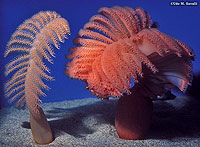
Fleshy Sea Pens, Ptilosarcus sp. (Order Pennatulacea)
| |
|
Class Scyphozoa — Jellyfish
Characteristics
- Medusoid stage predominates; polyps inconspicuous
- Thick gelatin-like mesoglea
- Often pigmented
|
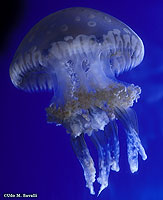
Spotted Lagoon Jelly, Mastigias papua (Order Rhizostomae)
|

Australian Spotted Jelly, Phyllorhiza punctata (Order Rhizostomae)
|

Upside Down Jellyfish, Cassiopea andromeda (Order Rhizostomae). This species relies on endosymbiotic algae.
|
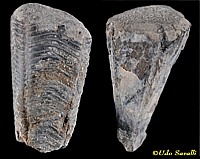
Conularids, such as these Conularia sp., are an extinct group thought to be related to the Sycphozoa or Staurozoa. Based onsome with preserved soft tissue, they attached at the narrow end, with tentacles at the upper end (Order Conulariida†).
| |
|
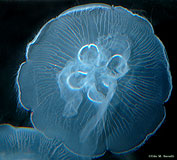
Moon Jelly, Aurelia labiata, adult medusa (Order Semaeostomae)
See also labeled photo.
|
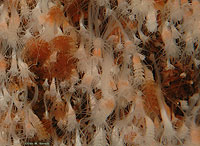
Moon Jelly, Aurelia labiata, polyps
|
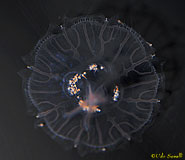
Moon Jelly, Aurelia labiata, ephyra
|

Moon Jelly, Aurelia sp., life cycle stages; stained whole mounts
| |
|
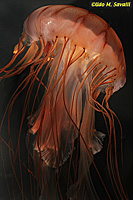
Northern Sea Nettle, Chrysaora melanaster (Order Semaeostomae)
|
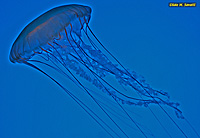
Pacific Sea Nettle, Chrysaora fuscescens (Order Semaeostomae)
|
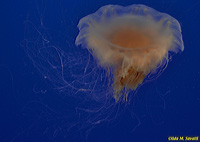
Lion's Mane Jelly, Cyanea capillata (Order Semaeostomae)
|
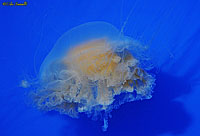
Egg-yolk Jelly, Phacellophora camtschatica (Order Semaeostomae)
|
|
Possible Cnidarians of the Ediacaran
Characteristics
- Optional content
- Cindarian affinities are debated for most of these
- Note general radial symmetry (Octoradial for Echmatocrinus
|
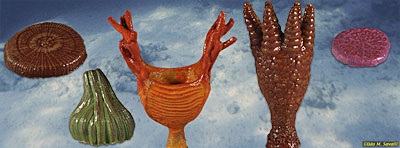
Possible early Cnidaria, from left to right: Medusinites (extinct class Cyclozoa); Inaria (possible cnidarian); Haootia (class uncertain); Echmatocrinus (probably an Octocoral; from Cambrian Period); & Mawsonites (possible trace fossil?). All except Echmatocrinus are from the Ediacaran. These are shown approximately to scale, with the tallest around 3 cm.
|
|
|

















































































